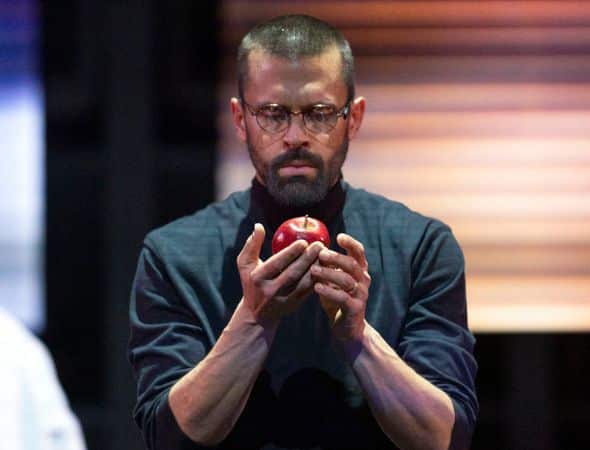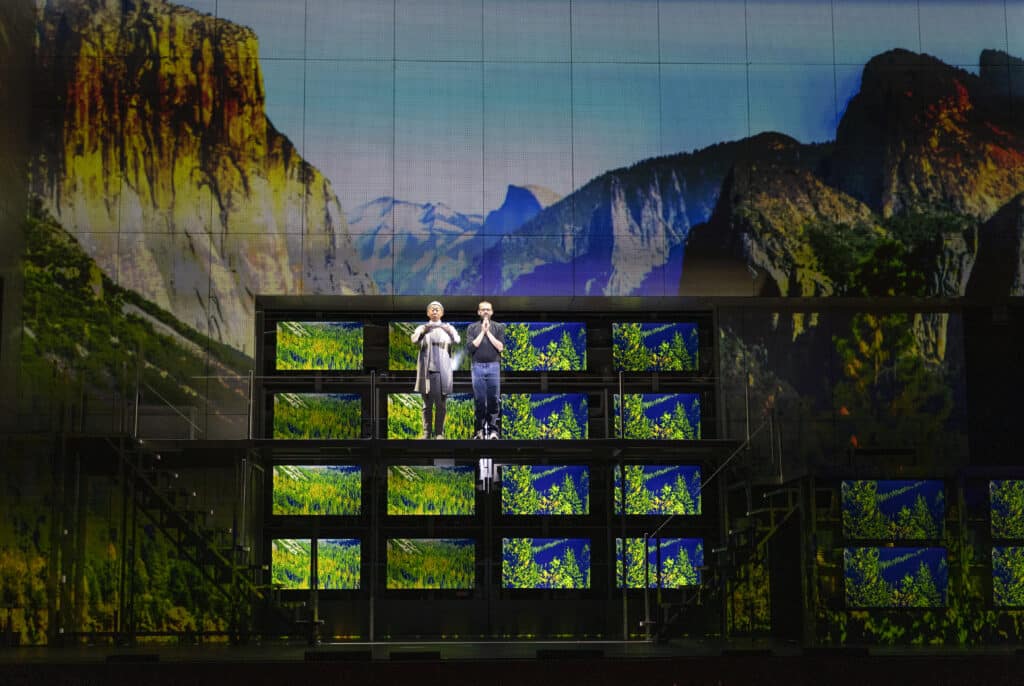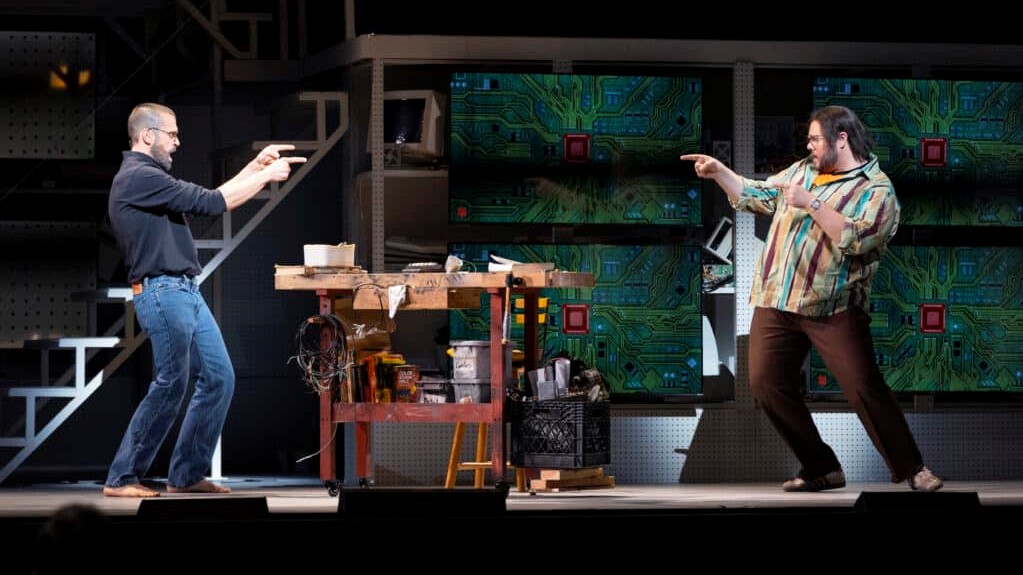SALT LAKE CITY — If you’ve read the biography about Steve Jobs (Steve Jobs: A Biography by Walter Isaacson), or any of the numerous films and documentaries about him, then this opera would make a nice addition to your belt. But if, like me, you knew very little about the famed CEO, you might walk away with more questions than answers.

Show closes May 14, 2023.
The (R)evolution of Steve Jobs, composed by Mason Bates & libretto by Mark Campbell, opens up to a metallic, and very sleek set. Throughout the opera, various actors sit on the benches waiting for their entries while providing this ominous air, causing me to wonder who these people were. The set has these massive light gray panels that form most of the backdrop, with a bridge that connects either side. There are stairs leading down to the main part of the stage with TV screens propped up on both levels and alongside the left wall. As soon as the opera starts we see Steve Jobs as a child, played by Declan Morrissey, with his dad, played by Stephen Pace, who has built him a workstation for his birthday. Down on the main stage, we see a bunch of journalists ready for a product launch, and they are taking pictures of adult Steve Jobs.
Not unlike a musical, the stage, designed by Jacob A. Climer, becomes an integral part in setting the stage for where we are and what exactly is happening. The giant panels behind Steve, played by John Moore, and the TV screen all over the set begin to reflect various images across time (this first part of the opera is set in 2007). As he shouts, “one device” the words are reflected on the giant screen. This continues throughout the opera – helping to guide the audience as we travel back and forth through time. In the 1970s, when Steve is with Woz, played by Bille Bruley, the panels reflect the roof of a house and the TVs show tools hung up on the wall as they’re working out of Steve’s dad’s garage. When Steve is with Chrisann, played by Amy Owens, everything looks like it’s on fire, when it’s meant to be a tree whose leaves have all turned red for autumn. And during this time, Chrisann has given him some psychedelics, and once the drugs kick in, everything turns purple. But the panels don’t just reflect place, they can also showcase feelings – such as when Chrisann tells Steve she’s pregnant, and he tells her to get rid of it and that he’ll disavow the child. In this moment, the screens begin to flicker and flash. The lights also begin to flash in a scene where Steve is being demoted by his board, but he instead chooses to quit and has a mental breakdown.
This opera has a lot going on; there are hardly any moments where the stage isn’t alight with new colors or images, or where characters aren’t engaging in some kind of argument, conversation or we’re traveling back and forth through time. There is a singular moment that feels deliberate and intentional, and it’s in 2007 when Jobs has come back from his walk, from earlier in the production, and his wife Laurene, played by Sarah Coit, is agonizing over how sick he looks and how he needs to go to the doctor. In this rather long scene, she tells him that although she loves him, she can’t stay with him unless he changes, because he has pushed away many of the people in his life. He finally acquiesces to see a doctor, but admits that it’s not easy for him. This time between the two of them is so relevant because throughout the opera, Laurene mostly just makes an appearance in Jobs’ life and this is the first time we really get to see her, or learn about her internal thoughts at all. It’s also one of the few times during the show where the stage isn’t doing anything but showing them be together. They kiss at the end of the scene, and walk off together before we transition to Yosemite to see their wedding via a flashback to 1991.

AUSTIN, TX – FEBRUARY 1, 2022 – Austin Opera presents the Texas Premiere of Mason Bates and Mark Campbell’s The (R)evolution of Steve Jobs at The Long Center.
The directing by Tomer Zvulun feels impeccable; there are multiple scenes involving a plethora of background characters who always seem to move in sync. In one scene, when we’re learning about Japanese calligraphy, the actors sit across from each other, symmetrically, and draw on each other’s boards. Later, they come together, holding their boards up, and enso is shown. There are multiple times in the show where everyone falls perfectly in formation, and even organized chaos such as toward the end of the production, a set of stairs are attached with Jobs atop them and the stairs are moved about the stage as the other actors maneuver around him. This feels as if it reflected what Steve Jobs was aiming for in his work (and in the opera). In addition to the directing, the music also felt well planned, and finely tuned; there is techno/electric music delicately weaved throughout the music giving it a modern feel. When Jobs and Kobun are talking in their first scene together, there are gentle flutes playing and the music feels meditative and intentional. When we see Jobs in the Zen Center (in the 70s) with Kobun, there is some choral singing from the extra actors and singing bowls that feel immersive for the setting. When we are shown Jobs and Chrisann in the 70s, the flutes are high pitched and fluttering – almost Disney like – as Owens sings to Jobs about how she feels about him, and this happens again when she meets Jobs later on and asks him to acknowledge their daughter. So much about the score is matched perfectly with the opera, and it really pulls you in and invites you to experience it fully.
Even though The (R)evolution of Steve Jobs feels like a technical triumph, the actual meat and potatoes of the opera can leave someone wanting. If you’re unfamiliar with the life and times of Steve Jobs, the former CEO of Apple, then pretty much everything, and everyone, would be new to you, and the opera provides very minimal insight into these relationships, except Kobun, played by Wei Wu, Jobs’ old spiritual mentor who died and appears as a ghost throughout the opera to offer insight and advice. As we move throughout time and space, traveling between the 70s up until 2011, we don’t learn any of the names of the women until the end of the play – Chrisann, the mother of Steve Jobs’ first daughter Lisa, and Laurene, Jobs’ wife. Woz is introduced early on, and we see them working together as young adults, hoping to fight “the Goliaths” and wall street behemoths; equating themselves to the likes of Che Guevara. But we never learn Woz’s full name (Steve Wozniak according to the program), learn about how they even met but we see that Woz and Steve still work together even as Jobs becomes more obsessed with his products, none of which are named, but the opera mostly focuses on the iPhone by implication.
Perhaps this is a deliberate choice as the opera is about Steve Jobs, and all the characters are there to give him more depth. Chrisann is his lover in the 70s, but he demands she get an abortion and will disavow the child that she ultimately keeps. Woz eventually chastises Jobs for becoming what they have always hated, a corporate prick, and quits. Laurene, despite being his wife, is given piecemeal characterization up until the near end of the opera. With Kobun, we learn about enso, a Japanese calligraphy symbol in the shape of a circle that can mean the void, or enlightenment. We also see Kobun advising Steve to simplify, something he fixates on for his products, and we see Jobs later on demanding that it look like a circle during a board meeting. So even as we learn more about Jobs’ Zen Buddhist mentor, we are actually just learning more about Steve.
The costuming, also designed by Jacob A. Climer, was a relief; John Moore as Steven Jobs stays in Jobs’ iconic black sweater, blue jeans plus sneakers combination for the entirety of the opera. Woz is distinct looking enough that the subtle changes between life in the garage and in corporate America are subtle and non-distracting. Chrisann wears her 70s attire throughout the entirety of the production so that we always know it’s her whenever she appears. The wardrobe is contemporary, except Chrisann, and although no one changes outfits to look like the 80s, 90s or early 00s – this would’ve been unwieldy. So keeping everyone in more or less the same clothes was the perfect choice.
As the opera seems to lightly touch many highlights of Jobs’ life, there are some moments that aren’t revealed, particularly the point when Jobs abandoned the ideology of his youth and became a Goliath, and then again when Laurene says at Jobs’ memorial that there was a Jobs 2.0 who would’ve wanted people to take things slower. Where and when did Jobs actually change into a different person? Is the audience meant to infer this change because he decided to go to the doctor to treat his illness? The opera does a much better job describing Steve’s idiosyncrasies, i.e., he is on an apple only diet in a 70s flashback, but doesn’t reveal how, when, or why Jobs changes.
This production feels like a great primer into the iconic Steve Jobs; it goes over all of his major life events without getting too bogged down into the details. Unlike other productions, it isn’t told in a linear fashion which can be disorienting at first, but is a different change of pace from typical storytelling techniques found in theatre. If you enjoy contemporary American opera sung in English and enjoy collecting information about Jobs, this is the perfect production for you. If you’re much newer to Steve and his personal journey to becoming the CEO of Apple, this can be a great place to start, but your journey should continue after the production is over.




